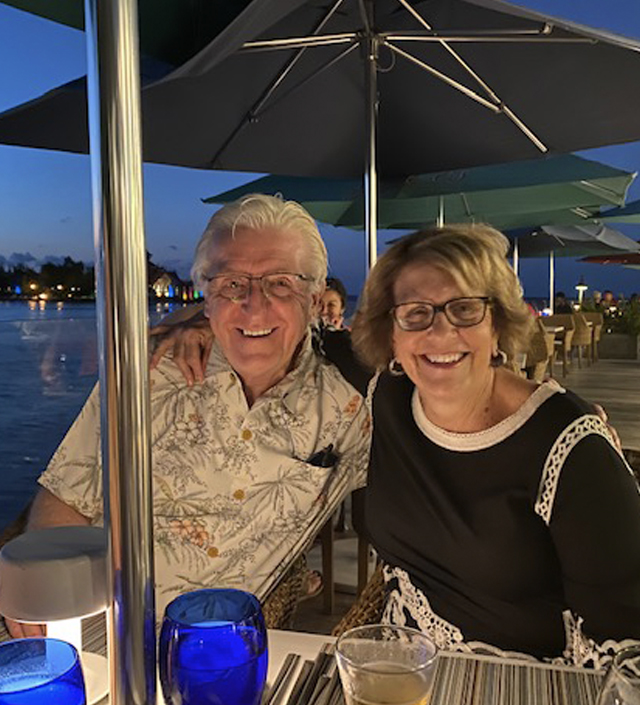As I toil at my desk, my husband, Murray, makes an announcement: “I’ve signed up for a ‘Taxes in Retirement’ talk at the library.” I continue looking at him, scrunching up my face, and reply, “Really, taxes?” My dear Murray and I have had many frustrating conversations over the years as I’ve nudged him to think more like a planner than the “you can’t take it with you” guy I married in 2010. Now he’s come so far that he’s starting to seek information on his own, in the wild.
“You can come with me if you want,” he says hopefully. I think it’ll be nice to spend time with him and to do some “research.” So to his satisfaction, I say, “Sure, can you sign me up with my personal email?”
A confirmation appears in my inbox a few minutes after Murray leaves my office. Did he sign me up before he asked me? No, the hosts of the talk are just that responsive; their campaign for attendance has begun.
We received no less than three confirming emails, three texts and two phone calls to ensure we will indeed show up. It’s no wonder that attendance campaigns are often necessary: According to statistics, the no-show rate for dinner seminars can be as low as 15% and as high as 60%, depending on whether it’s promoted with mailers or social media and search engine ads. In general, you can expect about 40% of registrants not to show up for free events.
At this point, I wouldn’t miss this talk.
I bet that many of you, like me, are haunted by thoughts of “Who else is talking to my client?” As advisors, clients inundate us with “what about (fill-in-the-blank)” distractions that they’re bombarded with in pitches from every direction. Many of the pitches sound quite enticing, so clients often ask me why I haven’t suggested them already.
Fly on the wall
We arrive at the library early, as requested, and find a signup sheet, pens with logos, and a friendly young man directing us to sit anywhere. We chose two seats in the front row. The room is set up classroom style with room for 24 people; 17 show up. I recall one of the emails declared this would not be a sales pitch so I’m a little surprised at the handouts in front of us, at a seminar on taxes in retirement, that talk about the number of bear markets since 1929.
The two presenters, a father and son, use a well-practiced, easy-to-digest banter as they go through 50-plus slides in our hour together. They make clear early on that this is not an interactive hour: They respectfully ask everyone to hold their questions to the end. It’s a boomer audience, so there are a couple of folks who want to be heard before our speakers get too far into their material. The son assures them he’ll come back to them at the appropriate spot in the program.
Since no one inquires about us audience members, I can remain incognito as an observer — which is a relief. I look to my left and see Murray poised to take notes in the notebook the hosts suggested everyone bring for that purpose.
Puppies, Tom Cruise and our ‘mistakes’
Murray has spent 40-plus years as a successful, professional salesman in the government contracting space. Anyone with the ability to sell understands the incredible earning potential that sales work offers. But high earnings come with increasingly high taxes, and Murray hates taxes. He raises the predictable questions every spring: “Why do we have to pay so much?” “I’m sure they made a mistake; did you check to see if it’s right?”
Back in the day, I ran a tax practice and I do check. Many of the ways we could defer taxes in the past have been eliminated.
But wait! Father and son have some ideas about how to save taxes. The first thing they need us to know is that we (the audience) are already doing a lot of things badly: We pay too much in fees, we’re overexposed to losses, and the markets will crash. Huh?
The presenters show a fun puppy video and a Tom Cruise clip, and the audience is listening. Father and son fly through Roth conversions, Social Security taxes, estate taxes and trusts. At the 40-minute mark, they get around to account location. Then more Roth conversions. They lament the cost of financial advisors (Why are we always the bad guys?), but neglect to acknowledge the cost of a tax attorney (the son).
The dad is the salesman, it’s not clear what his credentials are. It’s a family business that supports at least 16 people. I would not include anything they presented in one of my presentations. The paper pages for attendees stopped data at 2020 or before. The goal of the presentation became clear: get appointments.
False claims
During the slides on trusts, the presenters imply that we can be just like Donald Trump, Bill Clinton and Bill Gates by setting up our own charitable trusts. The audience emits audible groans, indicating they may be aware of the headlines around at least two of those folks when it comes to charitable trusts.
The name of the presenting company includes a religious reference and, lo and behold, the presenters’ fervor increases toward the end like any good sermon. We hear some rather incredulous claims such as, “We’ll save you 30%,” “A lot of our clients lost no money last year,” and “We’re on the brink of war!” I peek at Murray because he’s a history buff. Sure enough, he’s clearly confused by the statement on war and wondering what that has to do with taxes in retirement.
The final slide lists all the ways we can get in touch with the presenters after the seminar. The service prices are also crossed out and “value of $6,000” is declared under the “We are fiduciaries” banner. The slide also includes an “only $500 for attendees” pre-qualification offer and a QR code for quickly scheduling an appointment.
Escape mode
As Murray and I eye the exit, we are asked to complete the survey at the bottom of our pile of handouts. The “survey” is a calendar page showing the next two weeks; five appointments are available tomorrow. On the left side of the calendar, we are to circle one of nine choices ranging from, “I scanned the code and scheduled,” to “Please do not ever contact me again.” Ugh, I really don’t want to hear from them again, so I decide the kindest thing to do is to circle that last option.
Father and son are walking the room, scanning the surveys as we complete them. As the son heads our way, Murray indicates it’s time to leave.
On the walk back to our car, I ask him if the talk was helpful. “They give salespeople a bad name,” he replies, annoyed. “Well, did you find any of the information useful?” I ask again. “Can we do any of those things they mentioned?” he asks. “We can,” I reply, “but taxes are a ‘when,’ not ‘if,’ obligation.”
Back to reality
In the days since the seminar, Murray and I have further discussed the Roth conversion. He is now clear that you pay taxes now [with a Roth] or later. Later may end up being cheaper in the long run. We’re both currently healthy so we agree to pay taxes later, when our funds may be going to doctors instead of to travel. I further explain account location to Murray and demonstrate that besides our tax-deferred accounts, we have adequate funds in taxable accounts. We can tap into those taxable accounts, which for us modifies the need for Roth conversion. Yes, we will roll the dice rather than convert, but we are proactively and systematically determining what we expect to work best for us.
The case for online webinars
In my own office, I use online webinars to attract clients. We’ve been doing them successfully for decades although as times change, it’s admittedly getting more challenging to fill the audience. Everyone appears to be busy and distracted, and there’s also a lot more competition from online offerings. This makes it increasingly tempting to hire a company to fill a room to attract a more engaged audience. On the other hand, webinars are very inexpensive to put on, making them ideal business development tools.
Web-based programs can also reduce the need to rely upon some of the more expensive approaches to attract clients, such as treating them to event tickets, fancy dinners and heavily discounted fees. But keep your expectations in check: Landing even one client from a webinar or seminar is generally a good outcome. It’s also the most likely outcome, even when you present well. Statistics I’ve seen published show that the conversion rate from attendee to client hovers between 5% and 20%.
Whether you decide to hold events in person or online, remember that your audience is sharing their most precious commodity with you, the thing they cannot replace, their time. Work hard to repay them by making the time they spend at your seminar or webinar truly valuable to them, whether they ever become a client or not. Worry less about giving away solid information and answers, and probe more on what they came to hear.
Many seminars cull their attendee list prior to the event. For example, we Google all our attendees to know our audience. Sometimes someone comes back as an advisor/competitor. We call them to ask why they’re attending. Depending on that conversation, we welcome them or ask that they refrain from attending.
So, if you get the opportunity to be a fly on the wall in someone else’s talk, I highly recommend it.
Bonnie A. Sewell, CFP, CDFA, AIF, CEPA, is a managing director and senior wealth advisor with Dakota Wealth Management in Leesburg, Va. She works a lot with clients doing exits, whether leaving paid work, a spouse or selling a business. She can be reached at bsewell@dakotawm.com.







